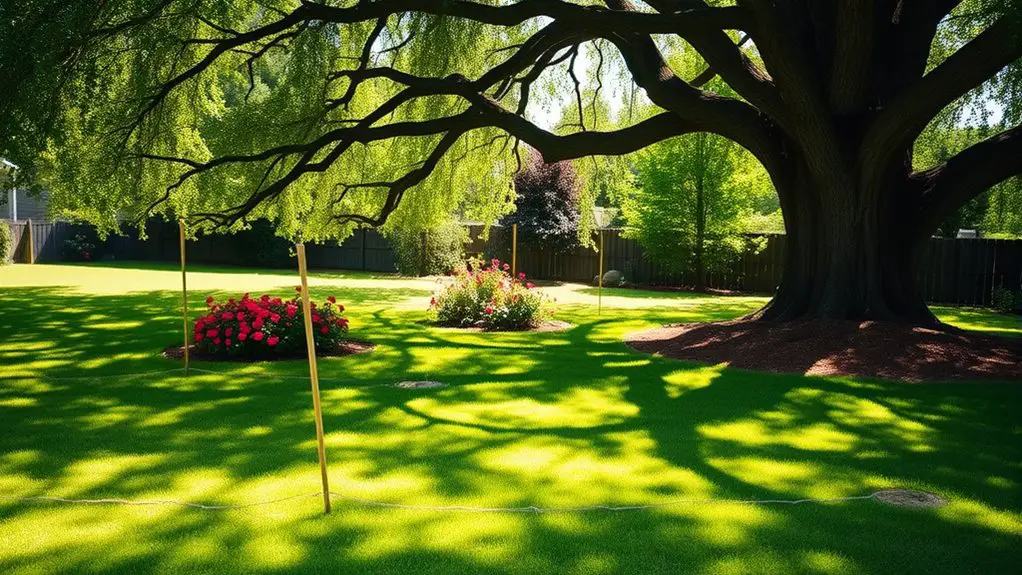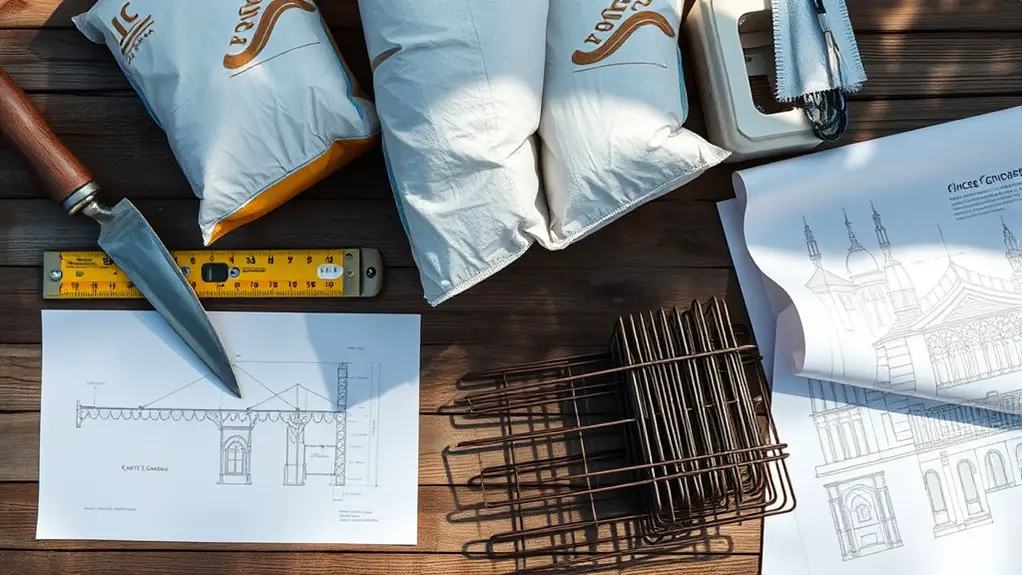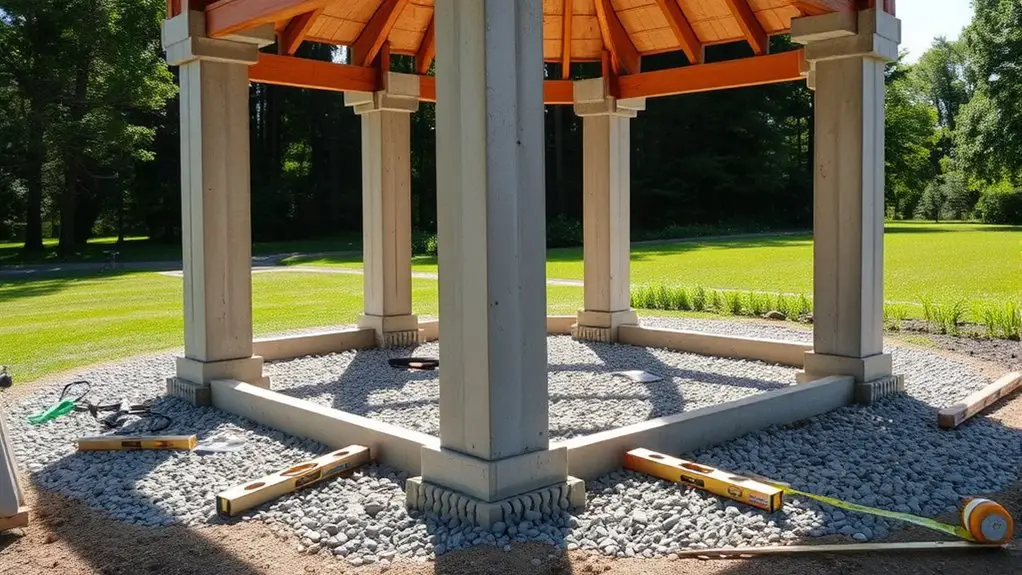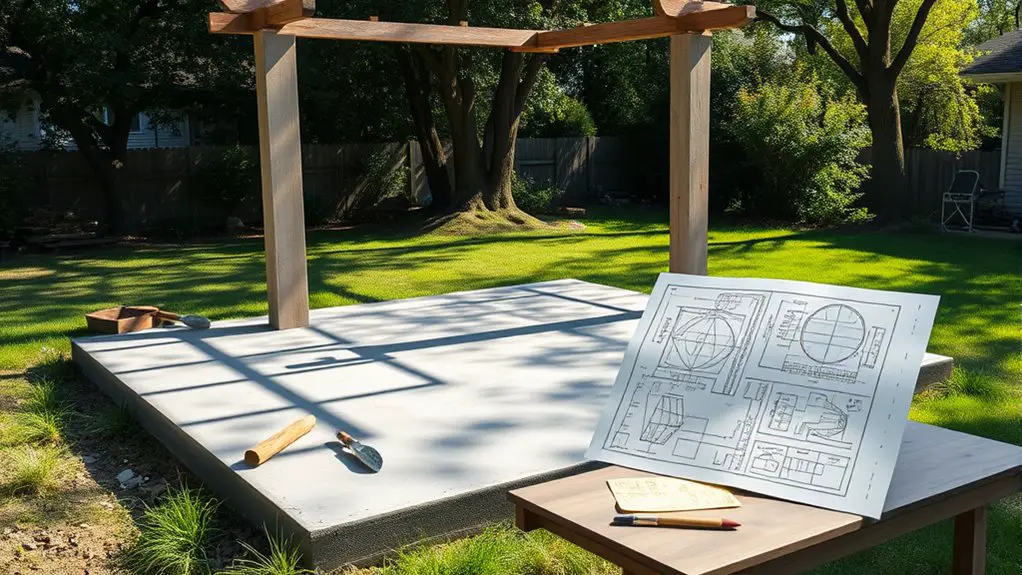To build a durable concrete gazebo, start by selecting the right location, considering sunlight and privacy. Design it with a suitable size, style, and materials. Prepare your site by clearing obstacles and leveling the ground. Next, lay concrete footings for stability and pour quality concrete for the base. Assemble the frame, then finish it with walls and roofing choices that reflect your vision. Finally, add personal touches for charm and functionality. There’s much more to explore to guarantee your gazebo stands out.
Choosing the Right Location for Your Gazebo

Where will your gazebo bring the most joy and utility to your outdoor space? Start by evaluating sunlight exposure. A well-placed gazebo can offer shade during the hottest parts of the day, allowing you to enjoy your garden without getting scorched. Consider the sun’s path throughout the seasons; positioning your gazebo to maximize shade in summer while allowing some winter sun can enhance comfort year-round.
Next, think about privacy considerations. You’ll want a location that shields you from prying eyes but still connects you to nature. Placing your gazebo near existing trees or hedges can create a secluded haven, letting you unwind without disturbances. Additionally, it’s essential to factor in wind and weather conditions to ensure that your gazebo remains a comfortable retreat throughout the year.
Ultimately, balance these elements to create a personal retreat that’s functional and inviting. By thoughtfully choosing the right location, you’ll guarantee your gazebo becomes a cherished part of your outdoor experience, offering both freedom and peace.
Designing Your Gazebo: Size and Style Considerations
When designing your gazebo, it’s essential to choose dimensions that suit both your space and intended use. Consider how different styles—from sleek modern to rustic charm—can enhance your outdoor aesthetic while providing functionality. Balancing size and style will guarantee your gazebo becomes a cherished addition to your landscape. Additionally, intended use should influence the design features and layout of your gazebo.
Choosing Dimensions Wisely
Choosing the right dimensions for your gazebo can make all the difference in achieving a harmonious design that complements your outdoor space. Start by determining the ideal gazebo dimensions based on your yard’s size and intended use. A smaller space may call for a compact design, while a larger area can accommodate a spacious retreat. Consider functional space planning; envision how you’ll use the gazebo—whether for entertaining, relaxation, or gardening. Ascertain there’s enough room for furniture and movement, allowing for an inviting atmosphere. Keep in mind the scale of surrounding structures, too, as balance is key. With thoughtful dimension choices, you’ll create a fascinating centerpiece that enhances your freedom to enjoy the outdoors.
Style Options Overview
As you commence designing your gazebo, it is essential to explore a variety of style options that not only reflect your personal taste but also harmonize with your outdoor environment. Consider modern designs with sleek lines and minimalist aesthetics, which can create a contemporary oasis in your backyard. Alternatively, traditional styles, like Victorian or rustic designs, offer timeless charm and a sense of nostalgia. Think about the materials and colors that will complement your landscape—wood accents can soften a modern look, while stone features enhance a classic design. Ultimately, your choice should resonate with your lifestyle and provide a versatile space for relaxation, gatherings, or simply enjoying nature. Embrace the freedom to create a structure that’s uniquely yours.
Gathering Necessary Materials and Tools

Before diving into the construction process, it’s essential to gather all necessary materials and tools to guarantee a smooth workflow. Start with a quality concrete mix; this will form the backbone of your gazebo, providing stability and durability. Look for a mix that’s easy to work with and suits your climate conditions.
Next, consider your tool storage—having everything organized saves time and effort. You’ll need a mixer, trowels, a level, and a shovel, among others. Don’t forget safety gear like gloves and goggles to keep yourself protected.
Additionally, purchasing a sturdy wheelbarrow will help you transport the concrete and tools with ease, allowing you the freedom to move around your worksite without hassle. With your materials and tools assembled, you’re ready to commence on the exciting journey of constructing your concrete gazebo.
Preparing the Site: Clearing and Leveling
Before you start building your gazebo, you’ll need to assess the area where it will stand. Clear away any debris, plants, or obstacles that could interfere with your structure’s foundation. Once the site is free of clutter, it’s time to level the ground to guarantee a stable base for your concrete work.
Assessing the Area
When starting on the journey to build a concrete gazebo, the first essential step is evaluating the area where it will stand. Analyze the site conditions: look for any slopes, rocks, or roots that could interfere with the foundation. A level surface is vital, so take the time to measure and appraise the ground’s flatness. Consider drainage considerations, too; make sure that water will flow away from your gazebo to prevent pooling and erosion. Ideally, you want the gazebo to enhance your outdoor space, not hinder it. By carefully evaluating these factors now, you’re setting the stage for a robust structure that’ll provide freedom and enjoyment for years to come. Embrace this groundwork, and your vision will flourish!
Removing Debris
Clearing the site of debris is an essential step in preparing for your concrete gazebo. Start by surveying the area, identifying any unwanted materials like branches, rocks, or trash. Effective debris removal not only guarantees a clean workspace but also prevents complications during construction. Use a sturdy rake or shovel to gather loose items, and for larger debris, a heavy-duty wheelbarrow can help transport waste efficiently.
Once you’ve collected everything, prioritize proper waste disposal. Check local regulations for guidelines on disposing of construction debris, as some materials might require specific handling. By taking these steps, you’re not just clearing space; you’re laying the foundation for a beautiful, free-standing structure that’ll enhance your outdoor experience.
Leveling the Ground
Leveling the ground is a critical step in ensuring the stability and longevity of your concrete gazebo. Begin by evaluating the terrain; any dips or rises need addressing. You’ll want to excavate high spots and fill in low areas, creating a smooth surface. Remember, effective ground drainage is essential to prevent water accumulation around your gazebo, which could compromise soil stability. Use a level to guide your progress, ensuring the surface is even. Compact the soil to enhance its strength, reducing the risk of shifting over time. Consider adding a layer of gravel to improve drainage further and provide a solid base for your concrete. By taking the time to level the ground, you’re setting the stage for a durable and beautiful structure.
Laying the Foundation: Concrete Footings
Before you start constructing your gazebo, it’s essential to establish a solid foundation with concrete footings, as they provide crucial support and stability. Begin by determining the appropriate foundation types based on your gazebo’s size and local soil conditions. Typically, for a standard gazebo, a footing depth of at least 12 inches is recommended, but this may vary according to frost lines and load requirements. A proper foundation not only ensures proper drainage but also enhances the durability of your gazebo.
Mark the layout where your footings will go, confirming they’re evenly spaced and aligned with your design. Dig holes to the specified depth, making sure they’re wider at the base for ideal support. Once your holes are ready, mix your concrete according to the manufacturer’s instructions and pour it into the excavated spaces. Use a level to verify each footing is even, allowing it to cure fully before proceeding. With robust concrete footings in place, you’re well on your way to a lasting, beautiful gazebo.
Constructing the Gazebo Frame

Once your concrete footings have fully cured, you’re ready to start constructing the gazebo frame, which is the backbone of your structure. Choose robust frame materials like treated wood or metal, as they’ll provide the necessary strength and durability. Begin by assembling the base using horizontal beams, ensuring they’re level for ideal structural stability.
Next, erect vertical posts at each corner and along the sides, anchoring them securely into the footings. Connect the top with horizontal rafters to create a sturdy overhead framework. Remember, your choices in frame materials directly influence the gazebo’s resilience against the elements and enhance its aesthetic appeal. Proper anchoring is crucial to ensure the stability of your gazebo against strong winds.
As you work, keep an eye on your measurements; precision is key. The freedom of your design lies in the details, so let your creativity flow while ensuring every component works harmoniously for a lasting structure.
Pouring the Concrete: Techniques and Tips
Before you pour the concrete, it’s essential to prepare the site meticulously, ensuring a level base and proper drainage. Once you’ve set the foundation, mastering finishing techniques will elevate the durability and aesthetics of your gazebo. Let’s explore the steps to achieve a flawless pour and a smooth finish.
Preparing the Site
Creating a solid foundation for your gazebo starts with careful preparation of the site, particularly when it comes to pouring the concrete. First, assess the soil stability; it’s essential for supporting the structure. Clear the area of debris and vegetation, then excavate to the desired depth, ensuring a level surface. Incorporate proper site drainage by sloping the ground away from your gazebo’s center, preventing water accumulation that could undermine your foundation. If the soil is loose or sandy, consider adding gravel to enhance stability. Finally, compact the ground thoroughly before pouring concrete. This meticulous preparation sets the stage for a durable gazebo that stands the test of time, allowing you to enjoy your outdoor sanctuary with peace of mind.
Finishing Techniques
Pouring the concrete for your gazebo is a critical step that demands attention to detail to guarantee a smooth, durable finish. Once your concrete is set, consider these finishing techniques to elevate your gazebo’s look:
- Staining techniques: Apply a concrete stain for vibrant color and depth. This not only enhances aesthetics but also provides protection.
- Sealing options: Use a high-quality sealant to guard against moisture and wear. This will extend the life of your finish.
- Smoothing: Before the concrete fully cures, use a trowel to create a sleek surface. This offers both beauty and functionality.
With these methods, you can achieve a stunning, long-lasting gazebo that stands out in your outdoor space. Embrace the freedom to personalize your project!
Finishing the Structure: Walls and Roof Options
The finishing touches on your concrete gazebo can greatly enhance its aesthetic appeal and functionality. When considering wall material options, you might opt for durable options like glass panels for an open feel or decorative wood slats that complement the natural environment. Each choice can create a different ambiance, allowing you to tailor the space to your liking.
For roof design choices, think about the practicality and style you desire. A flat roof offers a modern look but may require drainage solutions, while a pitched roof can provide additional headroom and rain runoff. You could even consider a thatched or green roof for a rustic, eco-friendly vibe. Additionally, using materials like polycarbonate for the roof can enhance insulation and UV resistance.
Whichever options you select, guarantee they align with your vision, creating a space that feels both inviting and liberating, where you can relax and enjoy your outdoor oasis.
Adding Personal Touches: Paint and Decor
While you might be enthusiastic to complete your gazebo, adding personal touches with paint and decor can truly transform the space into a reflection of your personality. Start by considering your color selection; vibrant hues or soft pastels can create different moods. Once you’ve settled on a palette, think about how you can enhance the ambiance with decorative accents. Here are a few ideas:
- Outdoor cushions: Incorporate weather-resistant fabrics that add comfort and style.
- Hanging planters: Use colorful pots to bring life and greenery, creating a fresh atmosphere.
- String lights: Install twinkling lights to add warmth and charm during evening gatherings.
Additionally, consider incorporating outdoor lighting options to enhance the overall decor and atmosphere. These elements can not only elevate the aesthetic but also make your gazebo a welcoming retreat. Embrace your creativity and let your gazebo become a space that truly speaks to you!
Maintaining Your Concrete Gazebo for Longevity
To guarantee your concrete gazebo stands the test of time, it’s essential to adopt a regular maintenance routine. Start with preventive maintenance by inspecting the structure for cracks or wear. Fill any gaps promptly to prevent water infiltration that can weaken the foundation. Weather protection is key; apply a waterproof sealant every few years to shield your gazebo from harsh elements. During winter, clear snow and ice to prevent undue stress on the roof. Additionally, keep the surrounding area free of debris and vegetation that may trap moisture, promoting mold or algae growth. Regular cleaning with a gentle, non-abrasive solution will maintain its aesthetic charm without compromising the concrete surface. Remember to schedule cleaning sessions based on usage and weather conditions to ensure optimal upkeep.
Frequently Asked Questions
How Long Does It Take to Build a Concrete Gazebo?
Building a concrete gazebo typically takes several weeks, depending on labor considerations and your construction timeline. Factors like design complexity and weather can influence the duration, so plan accordingly to guarantee a smooth process.
Do I Need a Permit to Build a Gazebo?
You’ll likely need a permit to build your gazebo, depending on local regulations. It’s crucial to check with your municipality to guarantee compliance, as permits can vary considerably based on size and location.
Can I Use Pre-Made Kits for Concrete Gazebos?
You’ll love discovering pre-made options for concrete gazebos! These kits offer advantages like ease of assembly and time savings, letting you enjoy your outdoor space sooner without the hassle of custom building. Freedom awaits!
What Is the Best Time of Year to Build a Gazebo?
The best time to build a gazebo is spring, when the weather’s mild and stable. You’ll enjoy ideal conditions for concrete setting, ensuring durability and longevity, while embracing the freedom of outdoor living in your new space.
How Much Does It Typically Cost to Build a Concrete Gazebo?
Typically, building a concrete gazebo costs between $5,000 and $15,000. Your budget considerations and material choices will greatly affect this range, so it’s wise to explore options that balance durability and aesthetic appeal.

